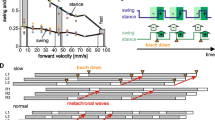Abstract
The uniformity of the neural physiology of an animal population is a fundamental, rarely tested assumption in most neurophysiological work. In this study, the variability of the timing between the movements of pairs of legs during free walking in cockroaches was assessed. Phases (a measure of timing) of motor bursts in muscles of legs in the American cockroach, Periplaneta americana, were calculated for insects walking straight over a flat, level surface. Student's t, Wallraff, Mann Whitney and Watson U2 two-sample tests were used to compare the phases of motor bursts of the same pairs of legs in different insects. The comparisons showed that in spite of the homogeneity both of the animal population and of the conditions under which the insects walked, most of the inter-leg phases of the animals that were compared were significantly different statistically. Further testing of greater numbers of insects using analysis of variance to test for population uniformity confirmed that the insects we tested were not members of a single statistical population with respect to the timing of motor bursts of the legs during walking. We infer that this unexpectedly large variability in a population thought to be relatively homogeneous reflects subtle but biologically significant differences between animals. The possible sources of these differences and their consequences for the study of behavior and its physiological basis are discussed.
Similar content being viewed by others
References
Cocatre-Zilgien JH, Delcomyn F (1988) Empirical evaluation of two-sample statistical tests for differences of stepping phase during insect walking. Biol Cybern 59:367–377
Delcomyn F (1971) The locomotion of the cockroach Periplaneta americana. J Exp Biol 54:443–452
Delcomyn F (1985) Walking and running. In: Kerkut GA, Gilbert LI (eds) Comprehensive insect physiology, biochemistry and pharmacology, vol 5, chap 11. Pergamon Press London, pp 439–466
Delcomyn F, Usherwood PNR (1973) Motor activity during walking in the cockroach Periplaneta americana. I. Free walking. J Exp Biol 59:629–642
Epstein S, Graham D (1983) Behavior and motor output for an insect walking on a slippery surface. I. Forward walking. J Exp Biol 105:215–229
Foth E, Graham D (1983) Influence of loading parallel to the body axis on the walking coordination of an insect. II. Contralateral changes. Biol Cybern 48:149–157
Franklin RF, Bell WJ, Jander R (1981) Rotational locomotion by the cockroach Blatella germanica. J Insect Physiol 27:249–255
Graham D (1972) A behavioural analysis of the temporal organisation of walking movements in the 1st instar and adult stick insect (Carausius morosus). J Comp Physiol 81:23–52
Kozacic JJ (1981) Stepping patterns in the cockroach, Periplaneta americana. J Exp Biol 90:357–360
Krämer K, Markl H (1978) Flight-inhibition on ground contact in the American cockroach, Periplaneta americana — I. Contact receptors and a model for their central connections. J Insect Physiol 24:577–586
Kutsch W (1973) The influence of age and culture-temperature on the wing-beat frequency of the migratory locust, Locusta migratoria. J Insect Physiol 19:763–772
Möhl B (1988) Short term learning during flight control in Locusta migratoria. J Comp Physiol A (in press)
Pearson KG (1972) Central programming and reflex control of walking in the cockroach. J Exp Biol 56:173–193
Pearson KG, Goodman CS (1979) Correlation of variability in structure with variability in synaptic connections of an identified interneuron in locusts. J Comp Neurol 184:141–166
Ritzmann RE, Tobias ML, Fourtner CR (1980) Flight activity initiated via giant interneurons of the cockroach: evidence for bifunctional trigger interneurons. Science 210:443–445
Robertson RM, Pearson KG (1982) A preparation for the intracellular analysis of neuronal activity during flight in the locust. J Comp Physiol146:311–320
Roffey J, Popov G (1968) Environmental and behavioural processes in a desert locust outbreak. Nature (London) 219:446–450
Shepherd D, Kämper G, Murphey RK (1988) The synaptic origins of receptive field properties in the cricket cercal sensory system. J Comp Physiol A 162:1–11
Simpson GG, Roe A, Lewontin RC (1960) Quantitative zoology. Harcourt Brace Jovanovich, New York
Spirito CP, Mushrush DL (1979) Interlimb coordination during slow walking in the cockroach. I. Effects of substrate alterations. J Exp Biol 78:233–243
Tang TP, Macmillan DL (1986) The effects of sensory manipulation upon interlimb coordination during fast walking of the cockroach. J Exp Biol 125:107–117
Truman JW, Riddiford LM (1983) Hormonal mechanisms underlying insect behavior. Adv Insect Physiol 10:297–352
Zar JH (1984) Biostatistical analysis, 2nd edn. Prentice Hall, Englewood Cliffs
Author information
Authors and Affiliations
Rights and permissions
About this article
Cite this article
Delcomyn, F., Cocatre-Zilgien, J.H. Individual differences and variability in the timing of motor activity during walking in insects. Biol. Cybern. 59, 379–384 (1988). https://doi.org/10.1007/BF00336111
Received:
Issue Date:
DOI: https://doi.org/10.1007/BF00336111




